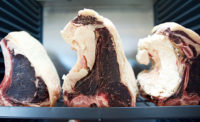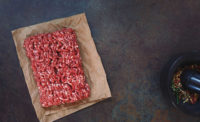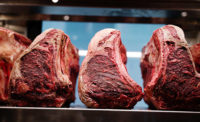Dry-aged beef has gained market share in Brazil over the last several years. Therefore, understanding the effects of the dry-aging process on beef quality, especially on the beef from Zebu cattle, is important because of the large volumes of production and availability of this cattle in that country.
As the market demand increases, a few opportunities exist to produce dry-aged beef regularly. One of them is a possibility of freezing the loins and storing them before aging. This procedure could be advantageous in reducing the seasonality of supplying high-quality beef to the marketplace and it would allow for a more competitive pricing. Another alternative is freezing the steaks after trimming and fabricating the dry aging, thus expanding the shelf life of the product while increasing its availability in the market place.
Freezing is a well-known, efficient method to extend shelf life. Furthermore, freezing can improve beef tenderness due to the structural breakdown of muscle fiber caused by ice crystal formation during the freezing and thawing cycle. The same process, however, can also cause undesirable oxidation and increase purge losses, both negatively affecting the quality of beef.
There is a limited number of studies exploring the effects of freezing and thawing, before or after dry aging, on beef quality attributes. Therefore, we evaluated the feasibility of producing dry-aged beef using previously frozen loins, and the effects of freezing on the dry aging weight losses and the physical-chemical and microbial characteristics. We also analyzed the impact of freezing on the meat key quality attributes of steaks fabricated from dry-aged loins.
Table 1. Weight losses (mean ± SEM) due to evaporation and trim losses
| DRY | DRY+F | F+DRY | P-VALUE | |
| Evaporation loss, % | 24.22 ± 0.72b | 24.33 ± 0.67b | 28.28 ± 0.83a | <0.0001 |
| Trim loss, % | 15.36 ± 0.38 | 16.58 ± 0.24 | 16.50 ± 0.55 | 0.258 |
a,b Different letters in a row indicate significant differences (P < 0.05).
Dry: dry aging the loin sections for 28 days; Dry+F: dry aging the loin sections for 28 days, steak fabrication and freezing of the steaks at -20 ºC; F+Dry: freezing of the loin sections at -20 ºC, thawing at 4 ºC/48 h and dry aging for 28 days.
Twelve pairs of striploins (left and right sides) from Zebu cattle were collected, at three days postmortem, and cut in sections. To avoid positional bias, the loin sections were assigned in a balanced fashion to one of the three treatments: dry aging for 28 days (Dry), dry aging for 28 days followed by steak fabrication and freezing at -20ºC for 30 days (Dry+F), freezing loins at -20ºC for 30 days, thawing (4ºC/48 h) and dry aging for 28 days (F+Dry). The F+Dry sections were vacuum packaged and stored in a commercial freezer at -20ºC. The remaining sections were dry aged in an adapted chamber. The chamber was set to work at 2ºC, 70 percent of relative humidity and 2,5 m/s of air velocity.
The F+Dry samples had 4 percent more evaporation loss than Dry and Dry+F samples. Freezing, before or after aging, had no effect on meat pH, thiobarbituric acid-reactive substances (oxidative rancidity) and shear force. However, water activity, moisture and cooking loss values were lower for F+Dry samples when compared to Dry and Dry+F samples. No differences were observed in the microbial counts between Dry and F+Dry samples. Also, the microbial profile (total bacterial, psychrotrophic microorganisms, lactic acid bacteria, Enterobacteriaceae and yeasts and molds) did not differ among the Dry and F+Dry treatments.
Our results clearly indicate that despite no negative effects on the microbiological counts, beef freezing before dry aging significantly increased dry-aging-related weight losses. Therefore, we conclude that freezing loins before dry aging is not a viable procedure for the beef industry. However, dry aging the loins, trimming and then freezing the fabricated steaks had no negative impact on the physical-chemical characteristics of beef, and thus can be considered as a feasible alternative to preserving the beef for longer periods than commercialize it as fresh meat.
As it is well known, the freezing process causes muscle fiber-structural break-down, which decreases the meat water-holding capacity, resulting in higher weight losses during the aging process. Therefore, despite the fact this study had been conducted with beef from Zebu cattle, we think the effects of freezing, before and after dry aging, can be extrapolated for beef from other cattle breeds.




Report Abusive Comment